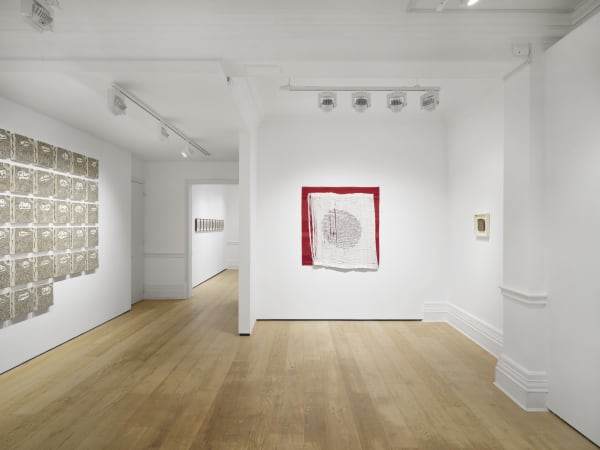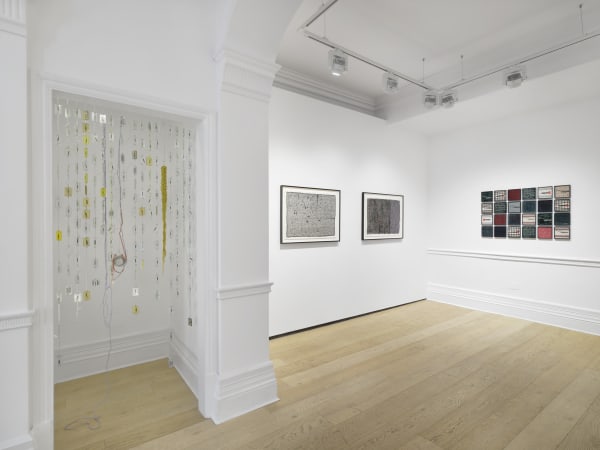The Resistance of Pen and Paper
“Thanks to the resistance of pen and paper, it does make one slow down and think." - Umberto Eco
“For all this time, however much I begged for pen and paper, they wouldn’t give it to me. I had thought of all the things I would write whenever they gave me pen and paper… Then yesterday, without my even asking for them, they brought me pen and paper. Those things I had so longed and waited for! What’s the use? Ever since yesterday, however much I rack my brains, I’ve got nothing to write.” – Sadegh Hedayat
Drawing inspiration from Umberto Eco's essay on handwriting, The Resistance of Pen and Paper brings together a group of artists from North Africa, the Middle East and Israel, who use calligraphy and written language to reflect on issues around identity, gender politics, cultural heritage and displacement. The artists included in the exhibition are: Nasrollah AFJEI (b. 1934, Iran), Maliheh AFNAN (1935, Palestine - 2016, UK), BRACHA L. Ettinger (b. 1948, Israel), Bita GHEZELAYAGH (b. 1966, Italy), Fathi HASSAN (b. 1957, Egypt), Huda LUTFI (b. 1948, Egypt) and Shirin NESHAT (b. 1957, Iran).
Born in Cairo and currently residing in Scotland, Fathi HASSAN is widely recognised for his unique, calligraphic style across photography, painting, drawing and installation. He gained prominence in the 1980s and was among the first African and Arab artists to be showcased at the Venice Art Biennale in 1988 and was included in this year’s Sharjah Biennial. Forced to relocate due to construction of the Aswan Dam, he moved from Egypt to Naples, Italy, in 1979, a move which exposed him to a new cultural milieu. He attended Art School in Italy and lived there for many years before eventually relocating to Edinburgh in 2018. Hassan’s practice draws on his Nubian and Egyptian heritage, experimenting with written and spoken ancient languages erased by colonial domination. Most scripts appearing in his works are based on Kufic calligraphy, but remain intentionally indecipherable. The exhibition will include his large-scale installation, Rosario (2010), consisting of 99 Arabic script words written in grey sand on white board blocks.
Fellow Egyptian artist Huda LUTFI’s series of collages, entitled Healing Devices, integrate abstract sculptural elements with calligraphic text on paper. Inspired by the mechanical designs in Ismail al-Jazari’s 12th century book The Knowledge of Ingenious Mechanical Devices, Lutfi takes the designs one step further, creating imaginary healing devices and formulas in Arabic script. “In the face of subjective and collective states of constraints and anxiety,” she says, “the actual practice of making these ‘healing devices’ brought about not only emotional relief, but also an open and playful process spurred on by the surprises of experimentation. Employing the methods of an “urban archeologist”, Lutfi’s practice draws heavily on her academic research and spans collage, painting, photography and sculpture. Her subversive works typically include elements of pop culture, political insignia and kitsch, blending various languages, imagery, and narratives together - from pharaonic, Arabian and African to European and Indian - to examine her culture’s complex relationship to its own past.
Bita GHEZELAYAGH is best known for her sculptural textile works that often incorporate calligraphic elements and other tropes of her Persian heritage. Born in Italy to Iranian parents, she grew up in Tehran until the Iran-Iraq War of the 1980s drove her to Paris where she studied and practised as an architect. Returning to Iran in the late 1990s, Ghezelayagh began working in the traditional craft of felt-making while developing her passion for turning traditional techniques into a modern mode of artistic expression. Within their literal ‘threads of connection,‘ her pieces explore notions of belonging that are both collective and personal.
Spanning the central wall in the first gallery will an installation of her series of silkscreen-printed calligraphic works on embroidered, hand-woven textiles. The exhibition also features a new body of work, which incorporates hundreds of antique pen nibs between sheets of glass, a form of 'encapsulation' that celebrates another historic material that has survived, fragile but stubborn, through centuries of civilisation.
Expanding on themes of cultural heritage, belonging and identity are the intricate, multi-layered works on paper by Maliheh AFNAN, who was recently included in the Whitechapel Gallery’s exhibition Action, Gesture, Paint Women Artists and Global Abstraction 1940–70 in London. Afnan’s practice was informed by archaeology, Persian miniatures, calligraphic texts, and ancient Near Eastern manuscripts, as well as the Western art historical canon. The artist moved from Haifa to Beirut and then to Washington DC, before eventually settling in London in 1997. Afnan's fascination with language led her to develop her own style of "writing her paintings". Working on an intimate scale, she employed various techniques to intentionally age her works and give them the appearance of ancient maps, scripts or relics, blurring the boundaries between past and present. The exhibition includes several works from her Veiled series from the 2000s, which aimed to shift the focus of the Western world away from the Muslim women's veil to methods of concealment as a wider concept.
The exhibition includes a display of BRACHA L. Ettinger's notebooks. Ettinger’s practice has its roots in her autobiographical past, in the history of her parents who survived the Holocaust; it explores the concepts of trauma, oblivion, the feminine and matrixial gaze, of the space of the unconscious and of the transition from invisible to visible enlightening art’s capacity of “healing”. Her notebooks, as her paintings, are characterised by a dimension between the abstract and the figurative, obtained through fine brush marks and layers of colour and shapes that create an atmosphere oscillating between darkness and light, and invite viewers to immerse themselves in an intimate and spiritual dimension.
Finally, the exhibition also includes seminal works by two Iranian artists, Shirin NESHAT and Nasrollah AFJEI. Neshat’s famous photographic series, Women of Allah explores notions of femininity in relation to Islamic fundamentalism and militancy in her home country, using symbols that are associated with Western representations of the Muslim world: the veil, the gun, the text and the gaze. Untitled is a prime example of Nasrollah Afjei’s meticulous, structural arrangements of calligraphic forms on a grand painterly scale. A member of the Iranian neo-calligraphists group, Afjei is a pioneer of the Naqqashi-khatt trend seeking to integrate the Arabic letter into elaborate artistic compositions.
The Resistance of Pen and Paper in the press:
Frieze Week Highlights | Apollo
Exhibition review & Interview with Bita Ghezelayagh | Arab News
For sales enquiries, please email sales@richardsaltoun.com
For press enquiries, please email sonja@richardsaltoun.com
-

In The Press
Bita Ghezelayagh & Resistance of Pen and Paper | Al-Monitor November 7, 2023Artist Bita Ghezelayagh speaks out in an interview with Al-Monitor about her featured works in the exhibition Resistance of Pen and Paper and how she...Read more -

In The Press
The Resistance of Pen and Paper | GQ October 24, 2023Gracie Eastwood talks about how the exhibition commemorates the enduring beauty of handwritten expression, uniting artists from the Middle East and North Africa as they...Read more

























